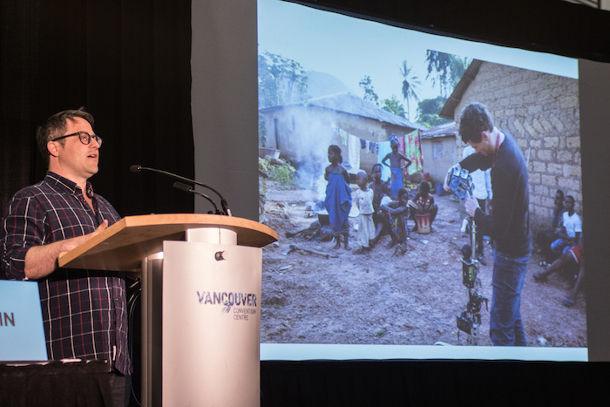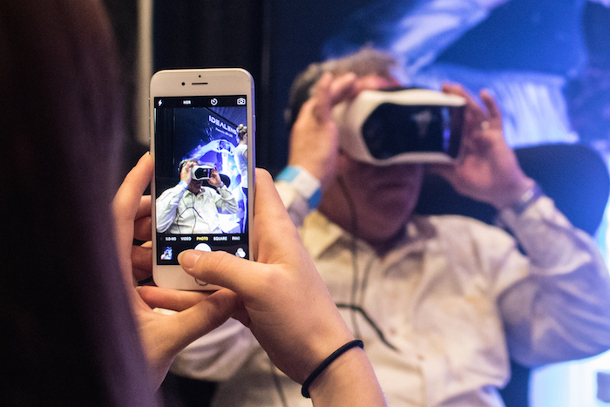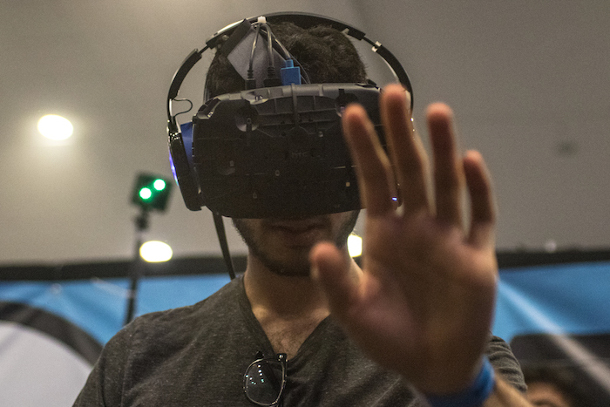Television brought scenes from across the world to your living room. Now virtual reality is bringing you to the scene.
When you're in, you're in. You can close your eyes, but you can't look away. A specially designed headset blocks out your actual environment and two focal lenses blast images that flood your field of vision. Noise-cancelling headphones broadcast sounds picked up from omnidirectional microphones.
It takes your other senses to remind your body it's an illusion.
The technology is a natural fit for videogames. Real estate companies are using it for virtual showings. Police departments and NFL quarterbacks are using virtual reality for training. Virtual reality has been shown to reduce pain in burn victims by showing them calm, cool environments.
Virtual reality's promise of full immersion has also drawn attention from journalists. Reporters have always tried to bring the story to the reader. Can they now use virtual reality to bring their audience to the story?
A flurry of virtual reality journalism hit the market at the end of last year. ABC launched VR coverage of Syria in September. PBS Frontline released "Ebola Outbreak: A Virtual Journey" not long after. CNN live-streamed a Democratic presidential debate in virtual reality a month later and then, in November, the New York Times sent out 1.3 million cardboard VR viewers so its readers could watch their first VR video, "The Displaced."
'It's a new medium'
"It's a new medium and we have yet to invent what it will ultimately be," said Graham Roberts, senior graphics designer for the Times. Roberts has produced a number of VR projects for the NYT, including "Vigils in Paris," which was nominated for a Pulitzer Prize. "It's going to take some time before we really learn how to tell stories native to this new medium, and before the great artists of the medium emerge. Citizen Kane was not made in the first year of filmmaking. When photography began, we were making 'instant paintings.'"
Experimentation with VR journalism may pick up this year with the release of the first two commercial headsets, Oculus Rift and HTC's The Vive, to the market. Those units aren't cheap -- HTC's Vive retails for C$1,149 -- but cheaper headsets that use phones as screens are also on the market and Google is selling VR viewers from cardboard for US$14.99.
The market is still small though, and while there are cheap alternatives to experience VR, there's no cheap way to produce it.
Taylor Owen, a senior research fellow at the Tow Center for Digital Journalism at the Columbia School of Journalism and executive producer on Frontline's "Ebola Outbreak," says the cost, cumbersome production equipment and lack of viewership are hindering the development of virtual reality journalism.
"If you're looking for an overall platform for journalism, this isn't it yet," Owen said at a panel on the subject at the first Consumer Virtual Reality Conference in Vancouver earlier this month.

Aside from his panel appearance, Owen also debuted his latest VR project at the conference. "Hidden in Plain Sight: Stories of HIV & Migration in Chile" was a complement to a duo of documentaries produced by Vice News and the University of British Columbia's School of Journalism that premiered Tuesday."There aren't norms of storyboarding in VR," Owen said. "We had a concept going into the field, but for both projects those concepts totally broke down [when we began] shooting in the field."
Shooting was also cumbersome. Owen said the team had to carry five extra suitcases of gear aside from their traditional documentary equipment. The 3D graphics for the seven-minute video ended up costing tens of thousands of dollars. Even the editing had astronomical costs.
Growing up in gaming's shadow
News outlets still aren't recouping these costs either.
A Knight Foundation report on virtual reality journalism found that "few virtual reality news experiences have attracted advertising. For the most part, the current reach does not provide the scale that brands and agencies are looking for." While the conference was sold out and hundreds of attendees packed talks throughout the day, the VR journalism panel attracted only about a dozen people. Booths with interactive video games where players could walk around and shoot bad guys attracted lines that took hours. The wait for "Hidden in Plain Sight" was rarely longer than a few minutes.
One viewer suggested the documentary should include options: choose who you can talk to, where you can go. It's a wish both Owen and Roberts share, but one limited by technology.

"The ultimate promise of VR is a convincing sense of presence," Roberts said. "Technological limitations push back against this."
Owen agreed that the state of the technology limits that immersive experience. "We're pretending we're giving power to the user to look around and move around," he said. "But it's an entirely constructed artificial world we're giving them, and there's zero interaction whatsoever."
Where 'smart' phones were in 1990
But technology is advancing rapidly as investors pump money into the industry. The Knight Foundation report said some experts estimate that the total VR hardware and software market will reach sales of $6.7 billion this year, and rise to $70 billion by 2020.
Mitch Ratcliffe, a senior analyst at BIA/Kelsey group, a media advisory firm, said VR technology is still a few "clicks" away from exploding the way smartphones did. He compared current headsets to an early '90s smartphone: technologically impressive, but bulky and filled with features, plug-ins and ports it probably doesn't need.
Current VR headsets are unwieldy and need to be plugged into a powerful computer to work. At conference booths, assistants held the necessary wires so viewers wouldn't trip over them while they gallivanted through their virtual worlds. Battery life for the headsets was also short, making waits to try them even longer.
Ratcliffe thinks virtual reality will take off when headsets become slim and light enough to carry around. They'll also have an option to switch to "augmented" reality (AR), where the real merges with the digital.

Roberts disagrees on the last point. He thinks users will want to keep their immersive VR experiences and enhanced AR experiences separate.
"I don't think their success needs to be tied together," Roberts said. "AR is going to be about wearables, and that is something people from many industries will need to get right. Just look at Google Glass." By contrast, "you don't have to look cool using VR at home."
"I fully expect the Times to enter this arena," Roberts predicted. But perhaps not just yet. "It's farther out before the tech is ready."
Owen, on the other, hand is excited about the possibilities AR will bring to the work of reporting: "Imagine being able to walk into a dataset and explore it from the inside!"
In The Impact of Technology on Journalism, John Pavlik argues that technology changes journalism in four ways: How journalists do their work, the content of the news, the structure of the newsroom and in the relationships between news organizations, reporters and their audience.
There might another technological revolution right around the corner. ![]()
Read more: Media















Tyee Commenting Guidelines
Comments that violate guidelines risk being deleted, and violations may result in a temporary or permanent user ban. Maintain the spirit of good conversation to stay in the discussion.
*Please note The Tyee is not a forum for spreading misinformation about COVID-19, denying its existence or minimizing its risk to public health.
Do:
Do not: